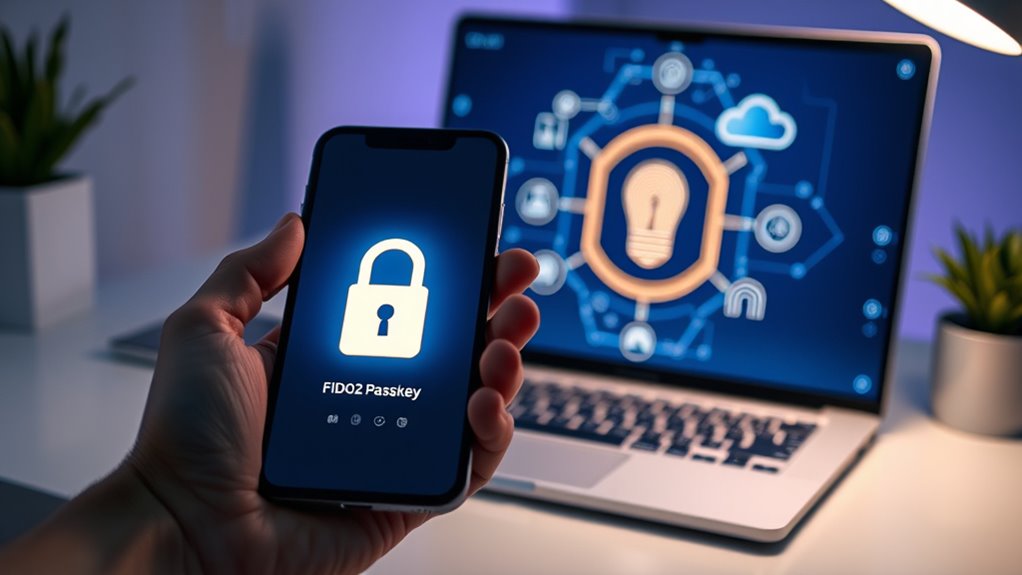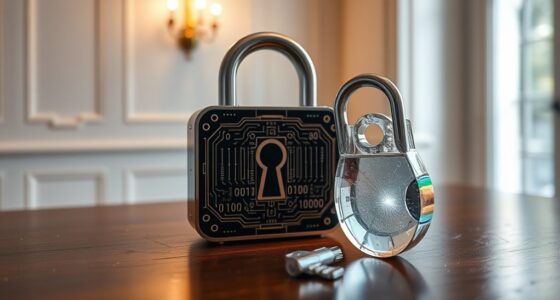Passwordless authentication is rapidly transforming how you secure digital access. Using standards like FIDO2 and passkeys, it replaces passwords with secure options like biometrics and device-based methods, making logins faster and safer. Cross-platform support and compliance with evolving regulations boost adoption, while emerging technologies like AI and advanced biometrics promise even better security and convenience. To explore how these innovations shape your future security, keep exploring what’s next in this evolving landscape.
Key Takeaways
- FIDO2 standards enable secure, phishing-resistant passwordless authentication using public key cryptography.
- Passkeys simplify login experiences across devices, replacing passwords with biometrics or device PINs.
- Growing awareness and regulatory support drive adoption of passwordless solutions in businesses.
- Advanced biometrics and AI technologies enhance security, accuracy, and user convenience in future authentication methods.
- Emerging tools like QR codes and decentralized identities expand the landscape of passwordless authentication options.
The Rise of Passwordless Security Solutions
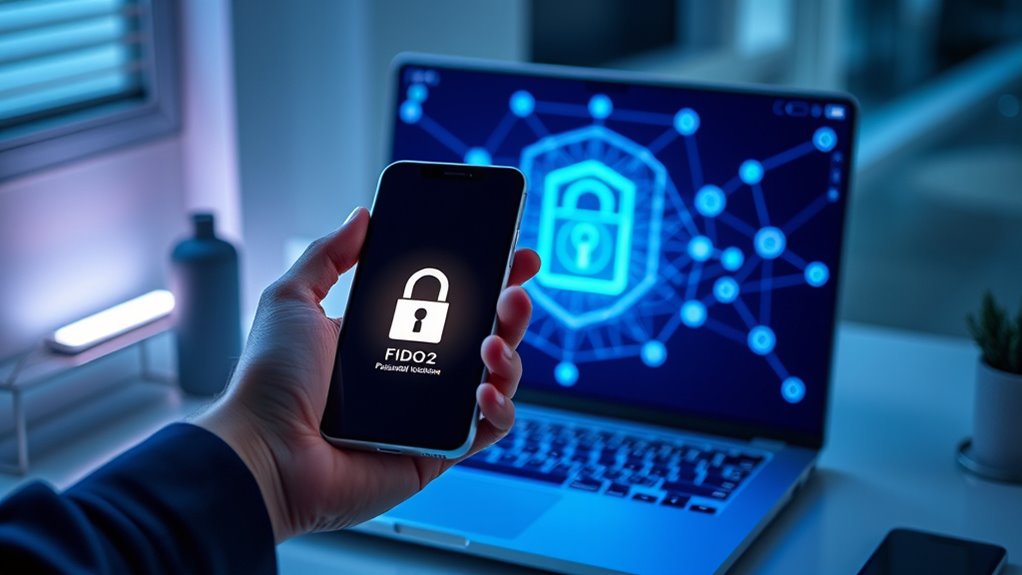
The rise of passwordless security solutions is transforming how organizations protect digital identities. Market size hit USD 22.14 billion in 2025 and is expected to grow rapidly, reaching up to USD 86.35 billion by 2033, with an impressive CAGR of nearly 19%. This surge is driven by increasing cyber threats like phishing and credential stuffing, prompting companies to adopt stronger, more seamless authentication methods. Regulations and government initiatives also accelerate this shift, especially in regions like North America and Asia-Pacific, where digital transformation is fast-paced. As cyber risks grow, organizations invest more in innovative technologies, including AI-powered biometric authentication. These solutions not only enhance security but also improve user experience, making passwordless options an essential part of future-proof cybersecurity strategies. Maintaining strong relationships with users and stakeholders further encourages adoption of these advanced authentication methods.
How FIDO2 Sets a New Standard for Authentication
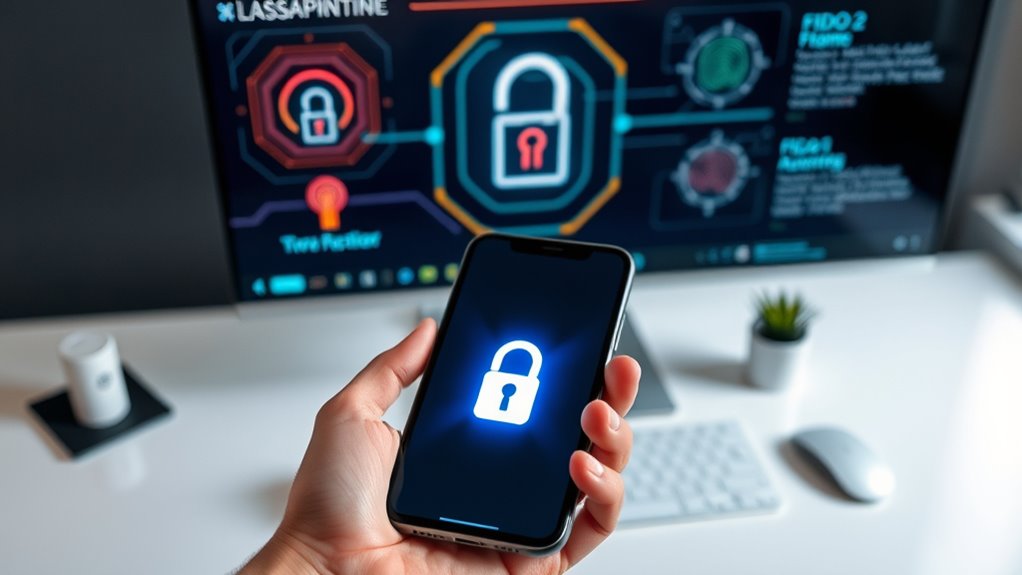
FIDO2 raises the bar by making authentication both more secure and easier to use. It blocks common threats like phishing and credential theft while simplifying login across devices. With this standard, you’re getting stronger security without sacrificing convenience. FIDO2 uses public key cryptography to ensure that only the legitimate user can access their accounts, protecting user privacy and preventing cross-service tracking. Additionally, its reliance on public key cryptography enhances security by eliminating the need for passwords, reducing the risk of data breaches.
Strengthening Security Measures
By replacing traditional passwords with cryptographic credentials, FIDO2 dramatically enhances security against common threats. Private keys stay on your device, making credential theft via phishing nearly impossible. Authentication involves unique cryptographic challenges each session, preventing reuse and replay attacks. Since no usernames or passwords are transmitted, traditional credential harvesting vectors are eliminated. Each credential is bound to a specific domain, thwarting spoofing attempts. Without shared secrets stored on servers, data breaches pose less risk. FIDO2 also protects your privacy by processing biometric data locally and ensuring no personal info leaks across services. This approach eliminates many vulnerabilities inherent in password-based systems and enhances overall security. Certified authenticators meet strict security standards, resisting tampering and attacks. This open, interoperable standard supports multi-factor and passwordless options, providing robust security for both individuals and organizations. The protocol’s reliance on public-key cryptography ensures that even if a server is compromised, user credentials remain secure.
Enhancing User Convenience
Replacing traditional passwords with cryptographic credentials streamlines the login process, making it faster and more intuitive for you. You no longer need to remember multiple passwords or go through frustrating reset procedures. Instead, you can authenticate using your device’s fingerprint, camera, security key, or smartphone, simplifying each step. This approach reduces delays and friction, delivering a smoother experience. User acceptance is high because many find it convenient to use “something they have” rather than passwords. Supporting various authenticators and devices, FIDO2 adapts to your preferences, whether biometrics, PINs, or security keys. It works across platforms, providing a unified experience on mobile and desktop. FIDO2’s compatibility with all major browsers and devices ensures broad accessibility, ultimately reducing frustration, lowering support needs, and making logging in quicker and more accessible for everyone. Additionally, security protocols based on cryptography ensure that your credentials are protected from common cyber threats.
The Role of Passkeys in Simplifying User Access

Passkeys considerably simplify user access by removing the need to remember and manage multiple complex passwords. Instead of typing or resetting passwords, you authenticate quickly using biometrics like your fingerprint or face, or a device PIN. They’re automatically synchronized across your devices through trusted cloud services, making login seamless whether you’re on your phone, tablet, or laptop. Passkeys also eliminate errors from mistyped passwords and reduce the risk of forgetting credentials. Because they use public key cryptography, private keys stay securely on your device, preventing theft even if servers are breached. This setup not only streamlines login processes but also enhances security by resisting phishing attacks and avoiding password reuse vulnerabilities. As adoption grows, passkeys are set to become the standard for simple, secure access across digital platforms. Additionally, passkeys rely on cryptography to ensure that user credentials are protected from common threats like hacking or data breaches.
Comparing Biometric and Hardware-Based Authentication Options
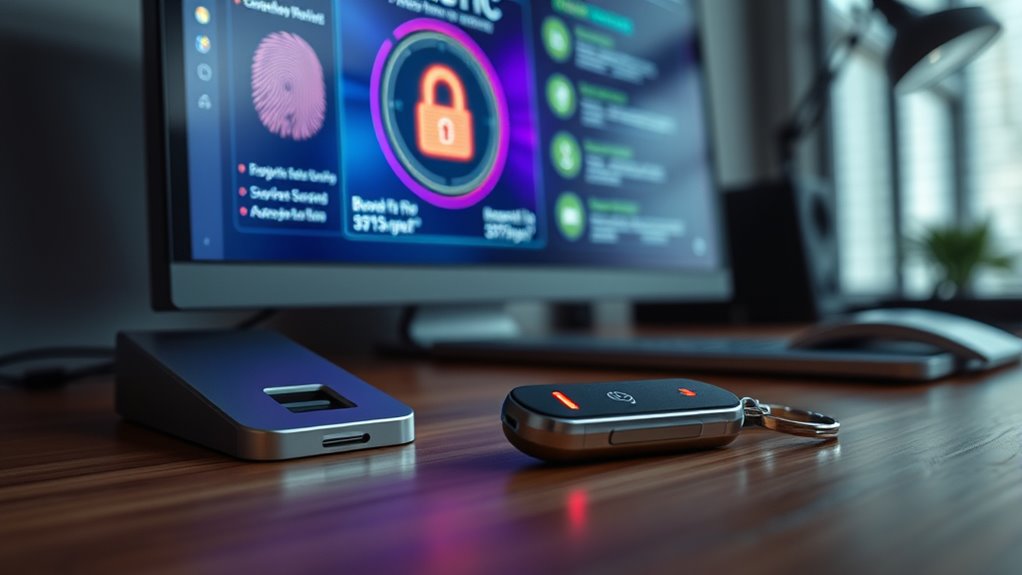
When choosing how to secure digital access, it’s important to understand the strengths and limitations of biometric and hardware-based authentication options. Biometric authentication offers high security because features like fingerprints or facial recognition are hard to replicate. It provides a seamless, convenient user experience and is easy to scale as your organization grows. However, storing biometric data raises privacy concerns, and implementing these systems can be costly. Hardware-based methods, such as passkeys, improve security by removing password vulnerabilities but depend on specific devices, which can limit access. They are simpler to implement and cost less upfront but pose recovery challenges if devices are lost or stolen. Both methods enhance security, but biometrics excel in user convenience, while hardware solutions emphasize straightforward deployment. Additionally, advancements in biometric encryption are helping to address privacy issues by securing biometric data with sophisticated encryption techniques.
Cross-Platform Integration and Its Impact on Adoption

Cross-platform integration plays a crucial role in driving the widespread adoption of passwordless authentication methods. It guarantees users can seamlessly move between devices and platforms without friction. Here’s how it influences adoption:
Seamless device and platform transition drives the rapid adoption of passwordless authentication solutions.
- Major browsers like Chrome, Firefox, Edge, and Safari support FIDO2, enabling cross-browser compatibility.
- Leading OS providers—Apple, Google, and Microsoft—support FIDO2, allowing passwordless login across Windows, Android, and iOS.
- Passkeys, built on WebAuthn standards, sync via user accounts, making them accessible across devices.
- Cross-device authentication (CDA) enables users to authenticate on one device using a passkey stored on another, simplifying multi-device workflows.
- WebAuthn’s open standards foster widespread integration, which encourages more developers and organizations to implement passwordless solutions. This widespread support helps to reduce fragmentation and increases interoperability among different platforms.
Overcoming Challenges: User Resistance and Implementation Costs

Despite the clear security and convenience benefits, user resistance remains a significant hurdle in adopting passwordless authentication. Many users believe passkeys are more secure, with 53% perceiving them as safer than passwords, and 54% find them more convenient. Raising awareness through education is essential, as 74% of consumers now know about passkeys, and demonstrating their security can build trust. However, implementing passkeys requires a user-friendly interface; 45% of consumers might abandon purchases if faced with password issues. On the technical side, costs rise due to browser support gaps, fallback options, and legacy system integration. Standardizing technology and phased rollouts can help reduce these costs, while education and clear benefits encourage user acceptance. Additionally, passkeys utilize advanced cryptography, making the authentication process both more secure and seamless for users. Furthermore, ongoing research and development continually improve security protocols, ensuring that passwordless systems stay ahead of potential threats.
Regulatory Influences Shaping Authentication Innovations

Regulatory requirements like GDPR, CCPA, and PSD2 push you to adopt stronger, privacy-focused authentication methods. These laws encourage innovations that protect personal data and meet compliance standards without sacrificing user convenience. As a result, regulations directly influence the development of passwordless solutions that are both secure and compliant. Strong authentication methods are essential to address these evolving legal demands and ensure organizations can uphold user trust while maintaining regulatory adherence. Additionally, the integration of AI-driven data analysis in authentication systems can help identify potential threats and adapt to emerging security challenges effectively.
Data Privacy Regulations
As data privacy regulations continue to evolve, they considerably influence how authentication systems are designed and implemented. You need to navigate a complex landscape where each state’s laws differ markedly. Consider these key points:
- Eight new state laws in 2025 increase compliance complexity, with unique requirements.
- Response times for consumer requests vary from 30 to 90 days, impacting operations.
- Embedding privacy controls like encryption and anonymization during system design reduces risks. This proactive approach aligns with privacy-by-design principles, ensuring security is integrated from the outset.
- Transparency measures, including consumer control tools and third-party disclosures, are now mandatory. Additionally, compliance frameworks help organizations stay aligned with evolving legal standards.
These regulations push you to adopt flexible, privacy-by-design frameworks that ensure compliance while maintaining user experience. Automated oversight and data minimization strategies become crucial to managing legal risks effectively.
Compliance Mandates Drive Innovation
Compliance mandates directly shape the landscape of authentication technology, pushing organizations to innovate in ways that meet regulatory standards while enhancing security. For example, FIDO2 supports Strong Customer Authentication (SCA) required by PSD2, ensuring secure payments. Its multi-factor authentication aligns with financial transaction regulations, while biometric data remains local, complying with GDPR and safeguarding user privacy. FIDO2’s device independence simplifies regulatory adherence across platforms and reduces dependencies. These standards unify protocols like U2F and WebAuthn, supporting legacy systems and enabling passwordless logins, which cut vulnerabilities. However, integrating FIDO2 can be costly and complex, demanding employee training and addressing biometric privacy concerns. Additionally, FIDO2 certification involves rigorous testing and validation processes, ultimately driving the development of robust, seamless, and secure authentication solutions that meet evolving regulatory requirements.
Emerging Technologies Transforming Passwordless Authentication
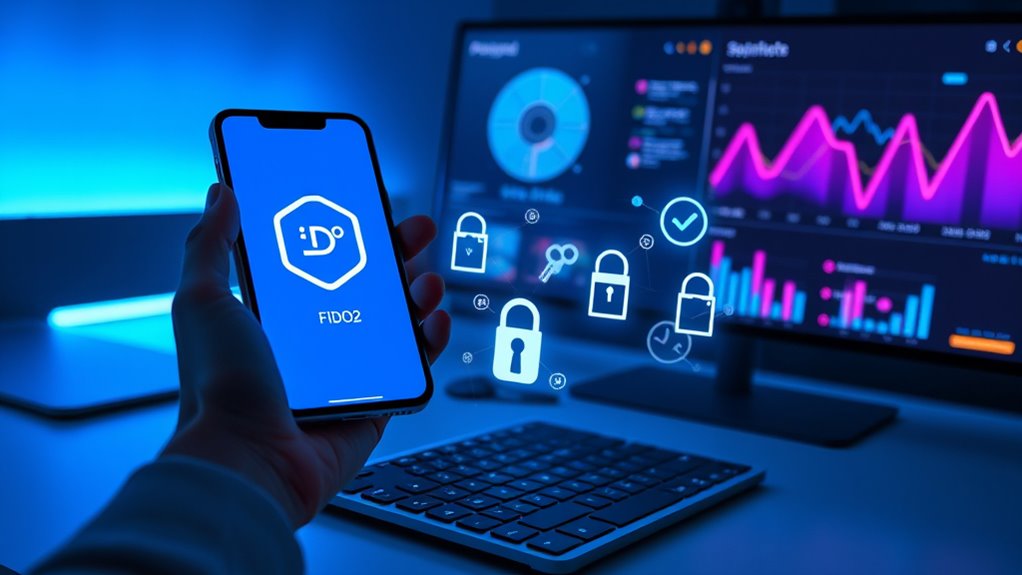
Emerging technologies are revolutionizing passwordless authentication by making it more secure, seamless, and user-friendly. Here are four key innovations transforming the landscape:
- Advanced Biometrics: Enhanced fingerprint and facial recognition reduce errors, while behavioral biometrics analyze interaction patterns for continuous, passive authentication. Liveness detection prevents spoofing, and multimodal biometrics combine face, fingerprint, and voice for added security. Biometric security standards ensure these methods meet rigorous privacy and safety requirements, increasing user trust and adoption.
- Passkeys: These cryptographic credentials replace passwords, are supported across billions of accounts, and simplify login through device biometrics or PINs, drastically reducing friction.
- Artificial Intelligence: AI improves biometric accuracy, monitors user behavior for anomalies, and enables real-time risk assessments, making authentication smarter and more adaptive.
- Alternative Methods: QR codes, decentralized identities, zero-knowledge proofs, and context-aware systems offer secure, privacy-focused options that reduce reliance on shared secrets and passwords.
Future Trends and the Next Frontier in Digital Security

The rapid advancements in biometric technologies, passkeys, and artificial intelligence are shaping the future of digital security, offering more robust and user-friendly authentication methods. You’ll see increasing adoption, with the market projected to reach nearly $22 billion in 2025 and organizations aiming for a 61% shift to passwordless solutions. Passkeys, resistant to phishing, are gaining ground, while biometric methods like facial recognition are becoming more secure thanks to AI and liveness detection. Cost savings and reduced support tickets drive organizational interest. Here’s a snapshot of future trends:
| Trend | Impact |
|---|---|
| Market Growth | Exceeds $20 billion in 2025 |
| Industry Adoption | 87% of IT leaders desire passwordless transition |
| Security Enhancements | Behavioral biometrics and AI improve detection |
| Integration Challenges | Legacy systems require strategic updates |
| Public Awareness | 57% familiarity with passkeys, rising rapidly |
The increasing reliance on biometric authentication methods is being complemented by AI-driven enhancements that improve accuracy and privacy, making these technologies more trustworthy and widespread. Additionally, the integration of AI-powered security solutions is expected to continuously evolve, providing adaptive and proactive protections against emerging threats.
Frequently Asked Questions
How Do Passkeys Enhance User Privacy Beyond Security?
Passkeys boost your privacy beyond security by ensuring your biometric data stays on your device, never leaving it or being stored on servers. This means your personal details aren’t shared or tracked across sites, preventing profiling or identity linking. Plus, each passkey is unique, so your activities aren’t linked, and phishing risks drop markedly. You enjoy safer, private online experiences without exposing sensitive information or risking data breaches.
What Are the Key Differences Between FIDO2 and Other Authentication Standards?
Think of authentication standards as different keys to a lock. FIDO2 stands out by offering passwordless, phishing-resistant security with hardware keys and biometrics, making it more secure and user-friendly. Unlike older standards, it supports cross-platform use with WebAuthn and CTAP, ensuring broader compatibility. Its design emphasizes simplicity and security, acting as a master key that adapts to modern digital doors, setting new benchmarks in authentication technology.
How Is Biometric Data Protected in Passwordless Authentication Systems?
You want to know how biometric data is protected in passwordless systems. In these systems, your biometric data stays on your device, never leaving it, thanks to local storage. Advanced cryptography safeguards your biometric info during storage and transmission. This setup prevents unauthorized access, phishing, and man-in-the-middle attacks, ensuring your biometric data remains private and secure while providing seamless, high-security authentication across different devices and platforms.
What Role Do Government Regulations Play in Shaping Authentication Technology?
Imagine a guiding hand shaping the future of security; that’s what government regulations do. They set clear standards that push you to adopt stronger, more secure authentication methods. By requiring compliance with open standards like FIDO2 and strict cybersecurity policies, they influence innovation and make sure your systems resist threats. These rules also encourage the development of privacy-preserving solutions, making your digital environment safer and more resilient against evolving cyber risks.
How Will Emerging AI Technologies Influence Future Passwordless Solutions?
Emerging AI technologies will considerably shape future passwordless solutions by enhancing security and user experience. You’ll see AI-driven adaptive authentication that adjusts in real-time based on risk, behavioral biometrics that create unique user profiles, and continuous monitoring to spot anomalies early. AI will also simplify onboarding, improve biometric accuracy, and develop innovative factors like gesture recognition, making authentication more seamless, secure, and personalized for you.
Conclusion
So, get ready to ditch those boring passwords and embrace the future of security — because who needs the hassle of remembering stuff when you can just blink, tap, or wave your way in? As tech evolves, you’ll wonder how you ever trusted those ancient strings of characters. The next frontier isn’t just passwordless; it’s seamless, smart, and maybe even a little magical. Welcome to the age where security is effortless — and passwords are finally dead.
